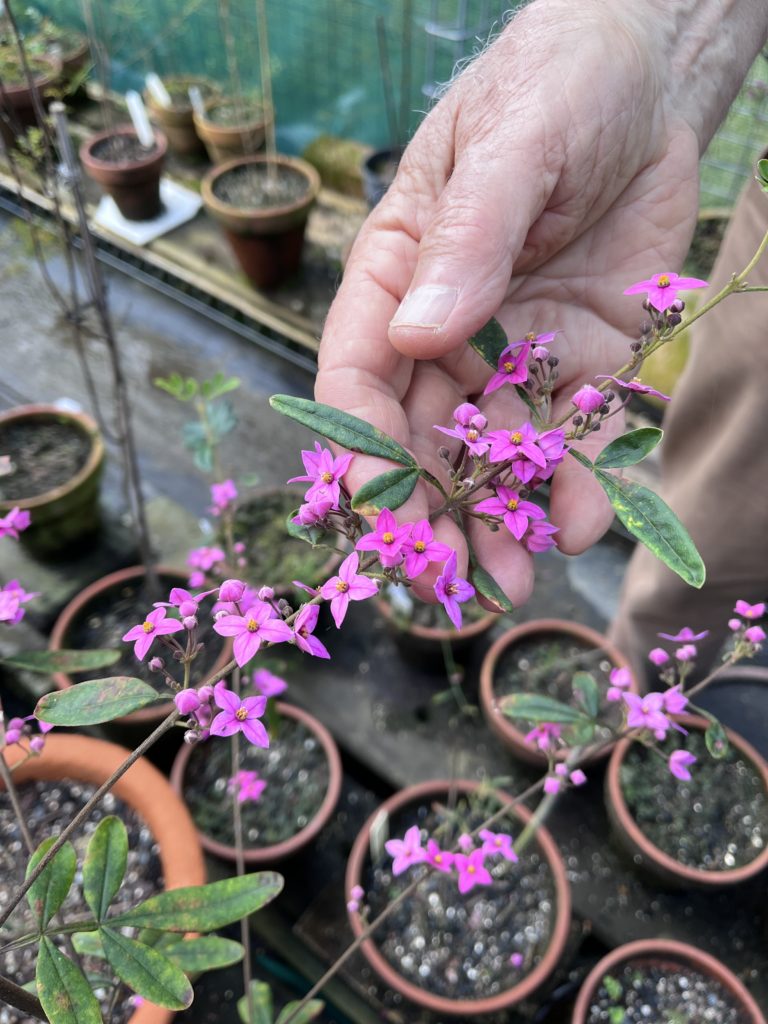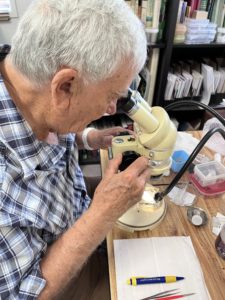With threats to honeybees frequently in the news, could native pollinators step into the role of pollinating crops and stone fruits? The first step is to learn more about the identities of Australia’s native pollinators and their interactions with native plants.
It can be a surprise to learn of fruit bats pollinating eucalypts, beetles and thrips pollinating cycads, and moths pollinating cheese trees (Glochidion species) and coffee bush (Breynia species) in well-known ecosystems. But the interactions of tiny moths with boronias are almost unheard of.
Pollination is the transfer of pollen from the male to female parts of flowers, enabling plants to set seed. Self-pollination occurs between flowers on the same plant. Cross-pollination occurs between plants, thanks to wind, water, insects, birds and other animals.
Native pollinators of boronias
Boronias and some closely related Rutaceae have intricate relationships with a family of moths, the Heliozelidae. These tiny, silvery moths are active during the day, like butterflies. Their larvae feed on developing boronia seeds and, when mature, fall to the ground and pupate underground. They emerge as adults in late winter and spring when boronias are in flower.
Liz Milla, who researches pollination at CSIRO, says many heliozelid species seem to simply feed on boronias. But some heliozelid and boronia species have evolved so that the moth also pollinates the boronias. In some cases this has resulted in a specialised obligate pollination relationship.
“This means the moth is the only species that can pollinate the plant, and the plant is the only species that can feed and shelter the moth and its larvae. I think this is the case for Boronia megastigma and its moth, which I studied during my PhD. The moths pollinate the flowers after they lay their eggs within the flowers so their larvae can feed on some, but not all, of the seeds,” she says.
“The females of this moth species have a scaly abdominal cleft that they use to collect and transfer pollen between plants. We think this structure may have coevolved together with changes to the flowers of Boronia megastigma,” she says.
Liz is now studying populations of Boronia megastigma, or brown boronia, in southwest Western Australia.
“We want to find out whether the moths, which are very tiny, can travel between remnant patches of boronias. This is important for conservation because the plants can’t set seed without their moths,” she says.
Floral features of boronias
Boronias are part of the citrus family, Rutaceae. Some species have very small distributions, growing in isolated patches in rocky areas or in native vegetation remnants on farms and along roadsides. Others are quite widespread.
Marco Duretto, a botanist at National Herbarium of New South Wales, says Australia is a centre of diversity for the citrus family, including boronias.
“Boronias occur from Cape York to southern Tasmania, with centres of diversity in southeastern Australia, Arnhem Land, the Kimberley and southwest Western Australia,” he says.
There are 134 known species. A few are from New Caledonia and the rest are endemic to Australia.
“The flowers of boronia species that we think may have heliozelid pollinators appear to have evolved wacky morphology,” Marco says.
“They have features like petals that are unusual colours or even different colours on either side, or that barely open; giant, black, sterile stamens; large bulbous stigmas; beautiful perfumes; and other floral features to direct moths to lay their eggs in specific parts of the flower. Other boronias associated with more generalised moths have simple flowers,” he says.
Interestingly, Marco’s recent evolutionary studies of boronias using DNA data showed that boronias with these interesting floral features aren’t that closely related to each other.
“It’s a kind of parallel evolution. We think some of these floral features evolved several times, quite recently, in species with specialised moth pollinators.”
Both Liz and Marco noted that boronias they think have heliozelid pollinators are also the species that produce beautiful floral fragrances. They assume this is to attract their pollinators. The rose boronia that grows in Sydney (Boronia serrulata) is one. And brown boronia fragrance is well known. The species is cultivated from cuttings and grown on farms to isolate chemicals from its flowers for use in fragrances.
Rearing moths

Retired CSIRO scientist Don Sands is studying threatened boronias and their moth pollinators at sites in southeast Queensland. Don cultivates wild boronias at home. When the boronias are in bloom during early spring, he places the potted plants beside their wild siblings as decoys.
“We hope the moths will lay their eggs on the flowers of the decoys. I’ll then rear the moths at home so that we have adult moth specimens for identification and naming,” Don says.
As well as discovering heliozelid species that are new to science and learning more about boronia-moth species pairs, Don wants to test the assumption that boronias can’t self-pollinate.
“I’m testing this experimentally by holding plants in confinement, away from any other potential pollinators,” he says.
Obligate pollinators and conservation
With some boronia-moth species pairs so intricately linked, what does this mean for conservation? As local climates change, might plants alter their flowering times and finish flowering before the adult moths emerge?
Pollination relationships could also be affected by greater impacts of fire on ecosystems. Plants can regrow after fires. However, if their moth pollinators were wiped out, they could find themselves growing in pollinator sterile areas.
Mick Andren, a Senior Conservation Officer with NSW Department of Planning and Environment, says the interdependence of moths and boronias provides a tiny window into the complexity of natural ecosystems.
“They make threatened species conservation programs increasingly complicated, because it is the interacting system of multiple species that requires attention if the program is to be effective in the long term,” he says.
Mick and Don are working together on Boronia repanda in northeastern NSW, on the Queensland border.
“Two species of heliozelid moth have been identified from the rare boronia and the next step is to investigate the life cycle of these species. Otherwise, a conservation management action that might help the plant in the short term, could unwittingly harm the moths and potentially lead to the loss of species,” Mick said.
“The impacts that fire might have on Boronia repanda, as well as its pollinators, is a key issue for this species and, of course, highly relevant more broadly,” he said.
Discovering new species

The interactions of boronias and heliozelids are being studied by a highly collaborative group of professional and amateur scientists. They include Liz Milla, Doug Hilton, Axel Kallies and Andy Young, who are supported by an incredible team of citizen scientists across the country. Together they have discovered hundreds of new species, which will be given formal scientific names in the years to come. The work is underpinned by making scientific collections of moth specimens in institutions like the Australia National Insect Collection at CSIRO. Although heliozelid larvae usually lay their eggs in boronia flowers, they recently found some larvae living in a gall in the stem of a boronia. They used DNA to match the larvae to an adult moth specimen, confirming the find.
Visiting boronias in bloom is one way to discover new species of heliozelids. But is the opposite possible? The team is also wondering whether subtle differences between moth species could help them recognise new species of boronias. Species of boronias not previously documented are still being discovered in the wild and in herbarium collections.
Thanks to Don Sands for his assistance in writing this article.
Read more about scientific naming of species at CSIRO.
